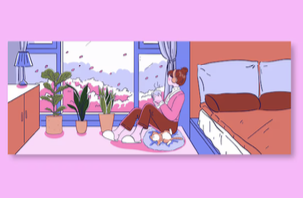Sam & Cat’s Bedroom
By: Emily Lehane
A bedroom is not just a general space that individuals sleep in and hold all their personal belongings, but it is a space that represents who a person truly is. The bedroom is a mostly private area; it is where an individual grows up, changes every day, finds out who they are as a person in a safe space. A bedroom is a public area when it comes to outside people experiencing the room just as a physical space; they can see everything, but they do not connect to the room like the individual that belongs to the room. The bedroom is physically, emotionally, and spiritually attached to the individual.
A bedroom always starts off blank; what is added to it is personal interest and likes. People express themselves through their rooms; everything they own or like is inside. The bedroom is a roadmap to an individual; it shows personality. From minimalistic to maximal, to edgy to modern, to cute and girly to hippy and vibey, from a person's clothes to the small knick-knacks on a desk, to organization skills to clutter and even to layouts—the bedroom is just a canvas of that person.
The bedroom also shows past, present, and future things and situations. "The distinction between interior and exterior behavioral residue is important because it emphasizes the breadth of information that is potentially available in a personal space, extending to behavior occurring well beyond the limits of its four walls." (Gosling, S. D., Ko, S. J., Mannarelli, T., & Morris, M. E. page 3). This explains that bedroom material is a way of telling a story. Interior behavior residue is when things inside the private environment say basically what is going to happen in the future—for example, if you leave a bag of chips on your desk, eventually you are going to open them and eat them. External behavior residue is something that happened outside this private environment and is shown in the physical private environment, for example someone saving plane tickets from their favorite vacation. The bedroom is an overall sacred space.
Siân Lincoln's book, "Youth culture and private space" states, "As Lincoln masterfully demonstrates, the connections between private and public space are continually rearticulated by young people with the effect that the contemporary young person's bedroom takes on inherently multifunctional qualities, being at once an individualized space for relaxation, study or recreation and a place for collective gatherings often associated with preparation for a 'night out' or a space to chill out in following a night on the town."
Sam and Cat Explained:
"Sam and Cat" was a famous TV show that aired on Nickelodeon, starring Ariana Grande who played Cat Valentine and Jennette McCurdy who played Sam Puckett. The show ran from June 8th, 2013, to July 17th, 2014. It was created by Dan Schneider, who also created other famous TV shows like "iCarly" and "Victorious." "Sam and Cat" was a crossover and spin-off from "iCarly" and "Victorious," where Sam and Cat played previous characters from these shows. Their characters never changed; the main purpose was to give these characters more attention, especially because they are opposites. The show is about these two girls running into each other and then deciding to move in together in an apartment. They learn they need to make some money, so they create their own babysitting business. Sam and Cat are significantly well known because of their split, half-and-half bedroom that both characters share. The room is split down the middle and is completely opposite to show how opposite the two girls' personalities and lifestyles are.
The Sam and Cat Bedroom:
The show "Sam and Cat" is purposely aimed to show the complexity of girlhood through their very different personalities, which is reflected in their bedroom. Their bedroom is so significant because it helps to understand how broad girlhood and girl culture are, and to show society's view of girls. "Girlhood studies is a multidisciplinary field of inquiry into the lives, experiences, and cultural practices of people who identify as girls, as well as an examination of how girls are discussed and represented in popular and academic venues. It draws from and informs diverse disciplines, such as education, psychology, sociology, history, literary studies, cultural studies, and media studies, and is often framed by feminist theories and methodologies." (Pomerantz 1). It can help reveal what it is like to grow up as a girl and experience girlhood.
This bedroom is easily recognizable. Sam's side is on the left, and Cat's side is on the right. Sam is very rebellious, edgytomboyoy, proud, loud, outgoing, fearless, and overall, not your typical "girl." Cat is very sweet, bubbly, "dumb," helpful, supportive, girly, cute, and very pink and would typically be seen as your average "girl." The things they like and dislike, and the way they act, can perfectly be represented through their sides of the room. Being complete opposites makes them work together because they fill the empty pieces missing in their own lives. For example, Cat is too sweet and needs to stand up for herself, which Sam would do for her. On the other hand, Sam is tough and needs to relax sometimes, and Cat is the perfect person for her because of how sweet and calm she is. These two girls can help show the reality of girls' differences.
Siân Lincoln's book, "Youth culture and private space," goes deep into the bedroom and how it reflects who a person is, not just through studying bedrooms, but he took the research to a next level. His methodology for understanding his main purpose was physically going to someone's house and entering their bedroom: "As I shall explore in this book, this is a space over which young people work hard to make it their own, to represent who they are at a particular age in their lives, what they have become and what they have left behind. Every bedroom that I have visited, while in many ways utterly predictable, has also been unique and, after getting to know my participants, it was clear that each bedroom represents their respective personalities, interests, and hobbies, their social, cultural, and everyday lives, whatever the extent of their use of the space."
Sam and Cat Influence:
Sam and Cat, as individual characters, have different impacts on different people, not just through this one TV series but even before Sam and Cat were created. They were stars in the TV series "iCarly" and "Victorious."From a societal point of view, Sam is seen as bad and is made to purposely get in trouble, while Cat is seen as innocent and supposed to be a "good girl." The Sam and Cat show demonstrates that even if a young girl grows up to be a tomboy or a little more confident and even leaning towards being rebellious, it does not define whether she is "good" or "bad." Any child can grow up in the way they wish to; the Sam and Cat show highlights how different these two girls are, but concludes how much they need each other and how good a relationship they have.
This show should give young girls confidence that no matter what they look like or like or dislike, there is always someone and people out there that will love them no matter what, and at the end of the day, everyone is still human. Unfortunately, young kids growing up and watching more teen-based shows can have a negative influence on them because kids believe everything they see and learn. "Television is a likely source for the initial construction of schemata for social roles and social scripts." And "In our model, schemata are absorbed from television in a conceptual context defined by the child's judged reality of television in general and different program genres in particular. Judgments about reality can be described on two Lehane 5 principal dimensions: (1) factuality – is the content 'true' in the sense that it represents events in the world outside television, or is it fictional, make-believe? (2) social realism- is the content realistic, plausible, or useful as a guide to the real world?" (Wright, J., Huston, A., Truglio, R., Fitch, M., Smith, E., & Piemyat, S.).
This research helps show how all the different things that are seen on TV can cause someone to think that life is supposed to be lived a certain way, especially in gendered stereotypical "roles." In this TV show, Sam is seen as a tomboy, and Cat is portrayed as a girly-girl. In the show, Sam always gets into trouble and is seen as "bad," and an example of that is her causing fights and getting arrested in the show, while Cat is represented to be a good, naive, clueless girl. Younger kids watching these shows are influenced because they may grow to think that if they act like Sam, they will be seen as bad, but if they act like Cat, they are seen as a sweet, innocent girl. The creator of Sam and Cat could also have a personal belief about how girls should act and what might happen to them if they act in certain ways.
Young girls, as they grow, have many challenges with personal growth and finding who they are without getting judged. With Sam and Cat, for example, some girls might have the desire to be like one of them; some may want to act or be like Cat because she is seen as "pretty" and "girly" because of the way her character is, and some may even want to be Sam because they feel a sense of rebellion in themselves and maybe even relate to Sam's differences. Some girls may be too afraid to be themselves and dress how they want because they don't want to look like a boy, but having Sam with her "do whatever she wants" personality can help girls grow up and feel that they should do whatever they want.
Conclusion:
Showing personality through a bedroom represents how complex and deep girlhood is. The bedroom is a very culturally gendered environment that is highly important to understand and break down because a bedroom is the root of an individual. Bedrooms are a way for self-discovery and empowerment. This all relates to girlhood and girlhood studies. The Sam and Cat bedroom and show was the perfect example of this understanding.
References
Gosling, S. D., Ko, S. J., Mannarelli, T., & Morris, M. E. (2002). A room with a cue: personality judgments based on offices and bedrooms. Journal of personality and social psychology, 82(3), 379. Lehane 7
Lincoln, S. (2012). Youth culture and private space. Basingstoke, England: Palgrave Macmillan
Pomerantz, S. (2020). Girlhood studies. In D. T. Cook (Ed.), The SAGE encyclopedia of children and childhood studies(pp 846–850). Sage.
Sam & Cat Wiki. (n.d.). Sam & Cat. Fandom. Retrieved December 9, 2024, from https://samandcat.fandom.com/wiki/Sam_%26_Cat
Schneider, D. (Creator). (2013–2014). Sam & Cat [TV series]. Nickelodeon.
Wright, J., Huston, A., Truglio, R., Fitch, M., Smith, E., & Piemyat, S. (1995). Occupational Portrayals on Television: Children's Role Schemata, Career Aspirations, and Perceptions of Reality. Child Development, 66(6), 1706- 1718.



